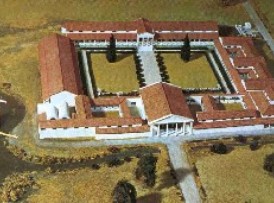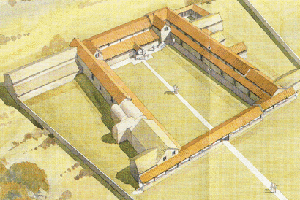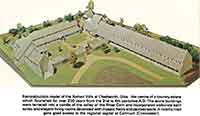The Rise of the Country Estate
plus Chedworth Villa
Introduction
As Britain became more prosperous under the Romans, so the wealth began to be spent by the landowners on their country residences. As most country dwellers owned a farm, they built homes to suit their lifestyles and amplify their status in the eyes of the community. The classic Roman villa came to Britain.
|
|
When they built these homes, their owners considered many factors.
- The size of the family living there.
- The purposes of the house. (Was it a home or something grander.)
- The budget available
- Whether it was meant to be a home or a showpiece of design and culture
- The impression the master wanted to make. (The size of his ego)
Plus anything else that may influence their final decision about the size and content of the final residence.
Therefore villas varied tremendously in size and complexity. The costs of building it were high considering the layout and contents. There were also other aspects such as wall paintings and mosaics. It was these that would push the costs up more than anything else. For example, the type of mosaic ('off the shelf' pattern or custom design) would have a great bearing on expenditure.
The country house
 Of course the Fishbourne villa was a one off project, and most of the country dwellings were a far more modest design. All the same, they were still grand compared to the homes the British upper classes lived in before the Romans.
Of course the Fishbourne villa was a one off project, and most of the country dwellings were a far more modest design. All the same, they were still grand compared to the homes the British upper classes lived in before the Romans.
Even so, many features were copied, in a scaled down manner, in the villas that sprang up across Britain. The Romans supplied architects, craftsmen, labour and financial help to the upper classes of the tribes who supported them, which is how many of the villas came to be built. The British working alone did not have the know how to take on such grand schemes. Most of the villas in Britain were the headquarters of farms and the estates of the lands they occupied.
The villa itself was a gradual introduction into Britain. Between 75 and 100AD. there is evidence of Roman villas replacing the traditional British wooden farmhouses around St. Albans.
The original villa was somewhat uninspiring, being rectangular in shape with five or six rooms  and a patio at the front. The roof was constructed of tiles and the interior floors were plain cement. If a mosaic was incorporated, this was usually of a plain design. Possibly this was due to economic restrictions due to the high taxes the Roman rulers imposed. Even so, the Romans were lenient towards those who had help them during the lead up to the invasion. The palace at Fishbourne in Sussex is a prime example of Romans and Britons working together.
and a patio at the front. The roof was constructed of tiles and the interior floors were plain cement. If a mosaic was incorporated, this was usually of a plain design. Possibly this was due to economic restrictions due to the high taxes the Roman rulers imposed. Even so, the Romans were lenient towards those who had help them during the lead up to the invasion. The palace at Fishbourne in Sussex is a prime example of Romans and Britons working together.
Farmers were not the only ones moved into villas, the town dwellers also began to see the benefits of a country residence. Of course it was the upper classes and the influential who could afford to have a town and country house. They wanted a retreat from the pressures of daily life in a built up area. It was inevitable that the style and size of the country villa would become more elaborate as new ideas and wealth came into Britain. These townies were used to a high standard of living and wanted this reflected in their villas, which is one reason they began to take on a more grand appearance.
It was not just the buildings that increased in quality. The British craftsmen learned new skills and built water inlets and drainage systems. The famous underfloor central heating became more widespread and they became more adventurous by building two storey villas.
By the end of the 3rd century, the villa had achieved the level of status symbol and was not just a home, it was also a statement. Many had pulled away from the traditional rectangular shape and had developed separate wings along with enclosed gardens and courtyards. The traditional villa had become a mansion.
Chedworth Villa, Gloucestershire, England
 <<Click thumbnail of Chedworth Villa
<<Click thumbnail of Chedworth Villa
A particularly fine example that has survived the rigors of time is Chedworth in Gloucestershire, England. This is indeed an example of a luxury residence, and even today would be considered advanced in it's refinement. It had several bedrooms, underfloor heating and even a sauna in one wing. This sauna is unusual in that it had a dry heat arrangement to encourage perspiration in the users. This would clean out impurities form the pores which they then cleaned off before plunging into the cold pool in the adjacent room. In another room was a traditional steam heat type of sauna.
The villa also had a reception room, splendid dining room complete with mosaic floor. There was also a well equipped kitchen. Attached to the kitchen were small rooms, presumably occupied by the servants.




















